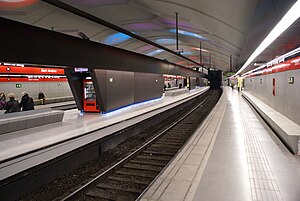Ferrocarril_Metropolitano_Transversal_de_Barcelona
Barcelona Metro line 1
Rapid transit line in Barcelona, Spain
Line 1, shortened to L1, coloured red and often simply called Línia vermella ("Red Line"), is the second oldest Barcelona Metro line, after line L3. It is the longest line of the Barcelona Metro, and links L'Hospitalet de Llobregat and Santa Coloma de Gramenet. Originally operated by the independent Ferrocarril Metropolitano Transversal de Barcelona, it is today operated by Transports Metropolitans de Barcelona (TMB) and is part of the ATM fare-integrated main transport system. L1 is the only metro line in Spain to use Iberian gauge tracks, as used by most Spanish main line railways.[1]
You can help expand this article with text translated from the corresponding article in Catalan. (August 2019) Click [show] for important translation instructions.
|
The line was created in 1926 as a means to join the rail stations the city had in the 1920s, and in preparation for the 1929 Universal Exposition. It has been growing since then to become a large line made up of 30 stations, as of 2007, the network's busiest one. These stations are architecturally homogenous, and as in the case of most metro lines in Barcelona, ornamentation is virtually absent from them. Some of them are improving their artificial lighting. Most of the line is underground, except for one short section, and at one point it shares tunnels with mainline tracks.[1]
Future plans are for the line to be extended southbound into El Prat de Llobregat and from its north terminus into Badalona, where it will join L2 in Badalona Centre.[1][2]

